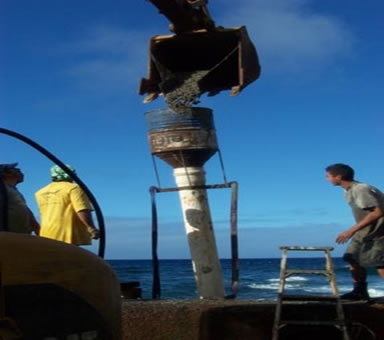Saad Iqbal | 🗓️Modified: November 7, 2016 | ⏳Read Time: 4 min | 👁Post Views: 1572
Have you ever wondered how the bridges spanning a river of thousands of meters width, stand in the flowing water? How the labor and workers can construct these piers and caissons? How civil engineers can construct piles of several kilometers into the ground by avoiding the underground water and letting concrete stand in it with full required strength?

You will be able to answer all of these questions after reading this article.
Civil Engineers can play with forces of nature, they can create holes into the rocks of kilometers length, they can divert the direction of river flow and many other examples have proved this fact.
Water is an ingredient and a major strength-deciding factor for concrete. Water cement ratio is a major research variable used in past decades and have very interesting and exciting results. This water initiates the hydration reaction in the concrete which is followed by hardening of the matrix and thus the concrete achieve its final shape.
The major trouble you will face if you increase the water in the concrete is cement washout in which the concrete with plenty of water will wash out the cement and then the slurry will escape from the matrix through pores of the formwork and thus the concrete will be deprived of cement content and hence the required strength will not be there.
Mechanism
A watertight rigid pipe usually of 200 mm to 300 mm in diameter having a funnel type hopper at the top and with a loose plug seal at the bottom discharge end is used to place concrete under the ground into the water. The lower end of the pipe is kept immersed in fresh concrete so that the rising concrete from the bottom displaces the water without washing out the cement content. This pipe is called Tremie and hence named Tremie method of underground concreting.
What is Tremie Method of Concreting?
The Tremie method works using gravity as the main driving force. The tremie pipe is of suitable length depending on the situation and in-situ conditions, the tremie pipes can be added more by coupling with one another. The concrete to be used in this method usually have a slump in the range of 150 mm to 200 mm.
One end of the tremie pipe is always to be kept into the concrete upto a depth of 1 to 1.5 m. This method is mostly used for pile foundation. The reason to keep the lower end of tremie pipe immersed in the concrete is to prevent intermixing of both concrete and water.
Tremie method is best suitable and convenient for pouring large amount of high flowable concrete. Tremie method should be done carefully and following points should be considered :-
1. The tremie pipe during concrete must be raised along with concrete placement so that the tremie may not get stuck which otherwise will cause many problems and may not even be removed from the bore hole.
2. The tremie pipe must not be of aluminum alloy as that will adversely affect the concrete due to chemical reactions between them therefore it should be avoided.
3. The diameter of the pipe, although it is between 200 to 300 mm but it should be sufficient enough keeping in the view the aggregate size so that they may not get stuck and cause blockage of the pipe. For 150 mm to 200 mm pipe diameter the limit for aggregate size is 19 to 40 mm.
4. The tremie pipe from the other end must be sealed properly with polythene sheet or wooden plate so that the water may not enter the pipe and it should be dry.
5. The tremie must be completely filled with concrete before giving jerk and breaking the seal. The concrete must be ensured to be in the pipe in order to avoid water to get into the pipe.
6. The sufficient supply of concrete from the batch plant should be ensured in order to avoid cold joint which will clearly deteriorate the quality and hence workability of the structure.















